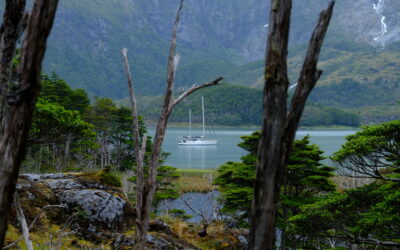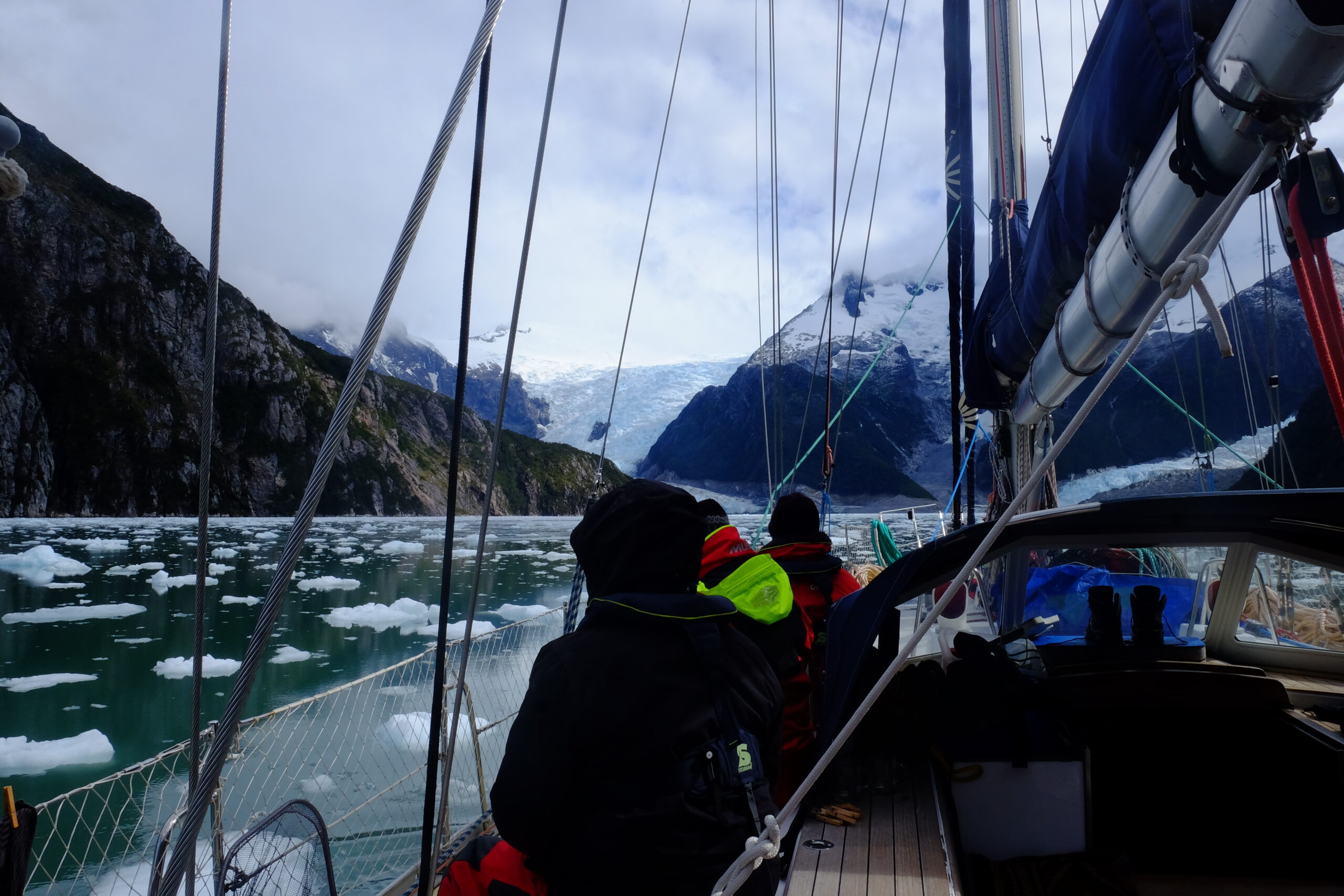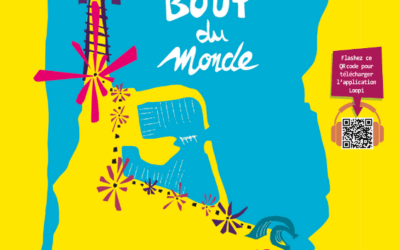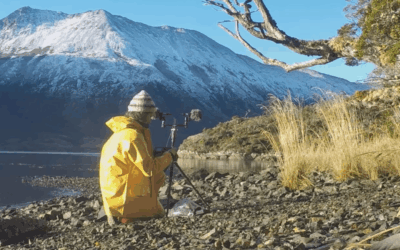[#7 – Ireland – Scotland 2024] From Loch Melfort to isle of Mull, via the Firth of Lorn

Association Karukinka
Loi 1901 - d'intérêt général
Derniers articles
Suivez nous
It is after a superb stopover made up of encounters as beautiful as the surrounding landscapes that we leave Loch Melfort to head towards the south of Mull Island. To do this, several options exist and we choose that of Cuan Sound, a (fairly) narrow channel separating Seil Island from its southern neighbors, Luing and Torsa. The conditions being too calm to advance solely under sail and arrive in time for the right moment of tide, it is with engine support that we enter the channel. The “eddies” (eddies) indicated on the map are there, accompanied by fairly anarchic current veins as they pass through the north of An Cléiteadh. The crew of the small Cuan ferry, connecting Seil and Luing, greets us and, past some ruins at the exit of the channel where sheep and cattle graze, we enter the inland Firth of Lorn (“Ann Linne Latharnach” in Gaelic), hoist the sails and let’s turn off the engine to cross this bay downwind and under full sail, under a big cloudless blue sky.
![[#7 - Cap au Nord 2024] De Loch Melfort à l'île Mull, via le Firth of Lorn 1 Le volet iodé de l'association Cruan Sound Karukinka](https://karukinka-exploration.com/wp-content/uploads/2024/05/Cruan-Sound_Karukinka-1024x768.jpg)
The Firth of Lorn(e) is a bay located in the continuity of the Great Glen fault (that of the Caledonian Canal). This place has been classified, taking into account the diversity of landscapes and species that inhabit it, as a protected area since 2014. As shown in the bathymetric maps of the Firth of Lorn, the relief of the seabed is similar to that of the surface. : cliffs, flats and peaks. All this contributes to creating very diverse conditions where species reaching their northern or southern migration limits respectively meet. The morphology of the seabed and its opening towards the Atlantic mean that it is better to go there in good weather to avoid static waves and whirlpools. The effects of the tide are strong there, with significant currents from the Great Race. In our favor during the crossing, this current accompanies us towards Loch Spelve.
We enter under sail in the evening, along green cliffs and revealing the first evidence of active volcanism more than 40 million years ago: columns of basalt (from lava) to the east and to the south of the loch and a mixture of granophyre (quartz-containing) and olivine-encrusted sandstone (sandy sedimentary rock) to the west and north.
![[#7 - Ireland - Scotland 2024] From Loch Melfort to isle of Mull, via the Firth of Lorn 1 Séjour voilier écosse, Séjour voilier Norvège, Croisière voilier Ecosse, Croisière voilier Norvège, Cap Nord à la voile, Sailing Norway, Sailing Scotland, Blue Water sailing, Stage voile hauturier, stage de voile côtier, sailing hébrides, voilier hébrides, navegar escocia, navegar noruega, navegar por los fiordos, velero escocia, velero noruega, navegar en finnmark, navegar en escocia, navegar en las hebridas, navegar costa oeste escocia, velero islas escocia, navegar islas escocia, sailing scottish islands, naviguer iles écossaises, Basalt Karukinka](https://karukinka.eu/wp-content/uploads/2024/05/Basalt_Karukinka-1024x768.jpg)
We leave sea farms on either side and drop anchor at the bottom of the west loch, to the sound of the cries of flying oystercatchers and the bleating of sheep. The calm is total and not a stir breaks the nighttime tranquility.
The next day we set off on foot for Loch Uisg, a large lake located in the axis of the Great Glen fault and surrounded by Loch Spelve to the north-east and Loch Buie to the south-west. All along the way we marvel at the rhododendrons which, unlike at home where they are shrub-sized, are made of real dense and richly colored wood. Kinlochspelve church overlooks the east bank and opens before us the horizon of a body of water on which everyone imagines what sport they could practice there: windsurfing, kayaking, wingfoil, kite, dinghy… we aren’t in lack of ideas and the small pontoon next to a lodge confirms to us that we are really not the first to think of it!
![[#7 - Ireland - Scotland 2024] From Loch Melfort to isle of Mull, via the Firth of Lorn 2 Séjour voilier écosse, Séjour voilier Norvège, Croisière voilier Ecosse, Croisière voilier Norvège, Cap Nord à la voile, Sailing Norway, Sailing Scotland, Blue Water sailing, Stage voile hauturier, stage de voile côtier, sailing hébrides, voilier hébrides, navegar escocia, navegar noruega, navegar por los fiordos, velero escocia, velero noruega, navegar en finnmark, navegar en escocia, navegar en las hebridas, navegar costa oeste escocia, velero islas escocia, navegar islas escocia, sailing scottish islands, naviguer iles écossaises, LochSpelve Karukinka2](https://karukinka-exploration.com/wp-content/uploads/2024/05/LochSpelve_Karukinka2-1024x768.jpg)
![[#7 - Ireland - Scotland 2024] From Loch Melfort to isle of Mull, via the Firth of Lorn 3 Séjour voilier écosse, Séjour voilier Norvège, Croisière voilier Ecosse, Croisière voilier Norvège, Cap Nord à la voile, Sailing Norway, Sailing Scotland, Blue Water sailing, Stage voile hauturier, stage de voile côtier, sailing hébrides, voilier hébrides, navegar escocia, navegar noruega, navegar por los fiordos, velero escocia, velero noruega, navegar en finnmark, navegar en escocia, navegar en las hebridas, navegar costa oeste escocia, velero islas escocia, navegar islas escocia, sailing scottish islands, naviguer iles écossaises, Loch Uisg Karukinka3](https://karukinka-exploration.com/wp-content/uploads/2024/05/Loch-Uisg_Karukinka3-1024x768.jpg)
![[#7 - Ireland - Scotland 2024] From Loch Melfort to isle of Mull, via the Firth of Lorn 4 Séjour voilier écosse, Séjour voilier Norvège, Croisière voilier Ecosse, Croisière voilier Norvège, Cap Nord à la voile, Sailing Norway, Sailing Scotland, Blue Water sailing, Stage voile hauturier, stage de voile côtier, sailing hébrides, voilier hébrides, navegar escocia, navegar noruega, navegar por los fiordos, velero escocia, velero noruega, navegar en finnmark, navegar en escocia, navegar en las hebridas, navegar costa oeste escocia, velero islas escocia, navegar islas escocia, sailing scottish islands, naviguer iles écossaises, Loch Uisg Karukinka](https://karukinka-exploration.com/wp-content/uploads/2024/05/Loch-Uisg_Karukinka-1024x768.jpg)
![[#7 - Ireland - Scotland 2024] From Loch Melfort to isle of Mull, via the Firth of Lorn 5 Séjour voilier écosse, Séjour voilier Norvège, Croisière voilier Ecosse, Croisière voilier Norvège, Cap Nord à la voile, Sailing Norway, Sailing Scotland, Blue Water sailing, Stage voile hauturier, stage de voile côtier, sailing hébrides, voilier hébrides, navegar escocia, navegar noruega, navegar por los fiordos, velero escocia, velero noruega, navegar en finnmark, navegar en escocia, navegar en las hebridas, navegar costa oeste escocia, velero islas escocia, navegar islas escocia, sailing scottish islands, naviguer iles écossaises, Loch Uisg Karukinka2](https://karukinka-exploration.com/wp-content/uploads/2024/05/Loch-Uisg_Karukinka2-1024x768.jpg)
![[#7 - Ireland - Scotland 2024] From Loch Melfort to isle of Mull, via the Firth of Lorn 6 Séjour voilier écosse, Séjour voilier Norvège, Croisière voilier Ecosse, Croisière voilier Norvège, Cap Nord à la voile, Sailing Norway, Sailing Scotland, Blue Water sailing, Stage voile hauturier, stage de voile côtier, sailing hébrides, voilier hébrides, navegar escocia, navegar noruega, navegar por los fiordos, velero escocia, velero noruega, navegar en finnmark, navegar en escocia, navegar en las hebridas, navegar costa oeste escocia, velero islas escocia, navegar islas escocia, sailing scottish islands, naviguer iles écossaises, LochSpelve Karukinka](https://karukinka-exploration.com/wp-content/uploads/2024/05/LochSpelve_Karukinka-1024x768.jpg)
![[#7 - Ireland - Scotland 2024] From Loch Melfort to isle of Mull, via the Firth of Lorn 7 Séjour voilier écosse, Séjour voilier Norvège, Croisière voilier Ecosse, Croisière voilier Norvège, Cap Nord à la voile, Sailing Norway, Sailing Scotland, Blue Water sailing, Stage voile hauturier, stage de voile côtier, sailing hébrides, voilier hébrides, navegar escocia, navegar noruega, navegar por los fiordos, velero escocia, velero noruega, navegar en finnmark, navegar en escocia, navegar en las hebridas, navegar costa oeste escocia, velero islas escocia, navegar islas escocia, sailing scottish islands, naviguer iles écossaises, LochBuie River Karukinka](https://karukinka-exploration.com/wp-content/uploads/2024/05/LochBuie-River_Karukinka-768x1024.jpg)
![[#7 - Ireland - Scotland 2024] From Loch Melfort to isle of Mull, via the Firth of Lorn 8 Séjour voilier écosse, Séjour voilier Norvège, Croisière voilier Ecosse, Croisière voilier Norvège, Cap Nord à la voile, Sailing Norway, Sailing Scotland, Blue Water sailing, Stage voile hauturier, stage de voile côtier, sailing hébrides, voilier hébrides, navegar escocia, navegar noruega, navegar por los fiordos, velero escocia, velero noruega, navegar en finnmark, navegar en escocia, navegar en las hebridas, navegar costa oeste escocia, velero islas escocia, navegar islas escocia, sailing scottish islands, naviguer iles écossaises, LochBuie Forest Karukinka](https://karukinka-exploration.com/wp-content/uploads/2024/05/LochBuie-Forest_Karukinka-1024x768.jpg)
![[#7 - Ireland - Scotland 2024] From Loch Melfort to isle of Mull, via the Firth of Lorn 9 Séjour voilier écosse, Séjour voilier Norvège, Croisière voilier Ecosse, Croisière voilier Norvège, Cap Nord à la voile, Sailing Norway, Sailing Scotland, Blue Water sailing, Stage voile hauturier, stage de voile côtier, sailing hébrides, voilier hébrides, navegar escocia, navegar noruega, navegar por los fiordos, velero escocia, velero noruega, navegar en finnmark, navegar en escocia, navegar en las hebridas, navegar costa oeste escocia, velero islas escocia, navegar islas escocia, sailing scottish islands, naviguer iles écossaises, Kinlochspelve Karukinka](https://karukinka-exploration.com/wp-content/uploads/2024/05/Kinlochspelve_Karukinka-1024x768.jpg)
We continue our walk towards Loch Buie to visit Moy Castle of the MacLaine clan of Lochbuie. Built in 1450 by Hector Reaganach Maclean, this three-storey castle, directly supplied with fresh water on the ground floor, was recognized by the King of Scotland in 1494. It was erected a stone’s throw from the bank in order to allow ships to easily access it. A still visible arch of stones served as a fish trap and several large blocks facilitate landing from small boats. It was the scene of clashes such as during the Jacobite revolt of 1689. This castle had to be restored at the end of this period and was also modified over the centuries to improve comfort (e.g. installation of a fireplace in the 16th century). It was only in 1790 that the MacLaine clan of Lochbuie left it in favor of a more comfortable neighboring habitat, once more peaceful times had returned: the Moy house. For several decades the use of Moy Castle was reduced to that of its dungeon as a prison.
![[#7 - Ireland - Scotland 2024] From Loch Melfort to isle of Mull, via the Firth of Lorn 10 Séjour voilier écosse, Séjour voilier Norvège, Croisière voilier Ecosse, Croisière voilier Norvège, Cap Nord à la voile, Sailing Norway, Sailing Scotland, Blue Water sailing, Stage voile hauturier, stage de voile côtier, sailing hébrides, voilier hébrides, navegar escocia, navegar noruega, navegar por los fiordos, velero escocia, velero noruega, navegar en finnmark, navegar en escocia, navegar en las hebridas, navegar costa oeste escocia, velero islas escocia, navegar islas escocia, sailing scottish islands, naviguer iles écossaises, Moy Castle Lochbuie Karukinka](https://karukinka-exploration.com/wp-content/uploads/2024/05/Moy-Castle_Lochbuie_Karukinka-1024x768.jpg)
![[#7 - Ireland - Scotland 2024] From Loch Melfort to isle of Mull, via the Firth of Lorn 11 Séjour voilier écosse, Séjour voilier Norvège, Croisière voilier Ecosse, Croisière voilier Norvège, Cap Nord à la voile, Sailing Norway, Sailing Scotland, Blue Water sailing, Stage voile hauturier, stage de voile côtier, sailing hébrides, voilier hébrides, navegar escocia, navegar noruega, navegar por los fiordos, velero escocia, velero noruega, navegar en finnmark, navegar en escocia, navegar en las hebridas, navegar costa oeste escocia, velero islas escocia, navegar islas escocia, sailing scottish islands, naviguer iles écossaises, Moy House Lochbuie Karukinka](https://karukinka-exploration.com/wp-content/uploads/2024/05/Moy-House_Lochbuie_Karukinka-1024x768.jpg)
The loch is so beautiful that we decide to return there with Milagro and enjoy a new excursion the next day to the megaliths. On our return to Loch Spelve we are no longer alone at anchor and meet the friendly neighboring crew, a trio of Scots impressed by the size and line of our Milagro. We invite them on board for coffee the next morning, before weighing anchor towards Loch Buie.
![[#7 - Cap au Nord 2024] De Loch Melfort à l'île Mull, via le Firth of Lorn 12 Le volet iodé de l'association Loch Spelve Karukinka3](https://karukinka-exploration.com/wp-content/uploads/2024/05/Loch-Spelve_Karukinka3-1024x768.jpg)
Navigation is across (4-5 Beaufort), leeward of Mull Island. We approach Moy Castle and enjoy a splendid view of the highest peak of the loch: Ben Buie (717m). We drop anchor in an indentation in the loch and disembark to see these famous megaliths. The weather is so beautiful that bathers are enjoying the nearby beach and we are quick to abandon the windbreakers and prefer t-shirts. The walk towards the megaliths leads us to the encounter of a meeting between deer and sheep. We follow the white stones showing us the way to the circle of megaliths. Before arrival, another site is spotted by Lauriane, a few hundred meters away, similar to certain tumuli-type tombs visible within the megalithic site of Saint Just in Brittany (composed of several rooms and an entrance corridor ). The sight of the circle of megaliths fascinates: what does it mean? The lack of scientific consensus on the subject allows everyone to project their imagination and see it as a ritual site, a monument linked to the alignment of the stars or even a gathering place to party!
![[#7 - Ireland - Scotland 2024] From Loch Melfort to isle of Mull, via the Firth of Lorn 12 Séjour voilier écosse, Séjour voilier Norvège, Croisière voilier Ecosse, Croisière voilier Norvège, Cap Nord à la voile, Sailing Norway, Sailing Scotland, Blue Water sailing, Stage voile hauturier, stage de voile côtier, sailing hébrides, voilier hébrides, navegar escocia, navegar noruega, navegar por los fiordos, velero escocia, velero noruega, navegar en finnmark, navegar en escocia, navegar en las hebridas, navegar costa oeste escocia, velero islas escocia, navegar islas escocia, sailing scottish islands, naviguer iles écossaises, LochBuie site megalithique](https://karukinka-exploration.com/wp-content/uploads/2024/05/LochBuie_site-megalithique-1024x768.jpg)
![[#7 - Ireland - Scotland 2024] From Loch Melfort to isle of Mull, via the Firth of Lorn 13 Séjour voilier écosse, Séjour voilier Norvège, Croisière voilier Ecosse, Croisière voilier Norvège, Cap Nord à la voile, Sailing Norway, Sailing Scotland, Blue Water sailing, Stage voile hauturier, stage de voile côtier, sailing hébrides, voilier hébrides, navegar escocia, navegar noruega, navegar por los fiordos, velero escocia, velero noruega, navegar en finnmark, navegar en escocia, navegar en las hebridas, navegar costa oeste escocia, velero islas escocia, navegar islas escocia, sailing scottish islands, naviguer iles écossaises, LochBuie Milagro Karukinka2](https://karukinka-exploration.com/wp-content/uploads/2024/05/LochBuie_Milagro_Karukinka2-1024x768.jpg)
After dinner at anchor the sky becomes thicker and a little rolling appears to lull us. We prepare for the next navigation to Iona, the sacred island.
Soon we will publish a short video summarizing our stops at Loch Spelve and Loch Buie and incorporating images of the megalith circle.
Views: 20


![[Heading South #13] From Buenos Aires (Argentina) to Puerto Williams (Chile) – Final Part](https://karukinka-exploration.com/wp-content/uploads/2025/07/IMG-20250124-WA0017-1-400x250.jpg)
![[#8 – Ireland–Scotland 2024] from Loch Buie to the sacred Isle of Iona](https://karukinka-exploration.com/wp-content/uploads/2024/07/Iona_LL-400x250.jpg)


